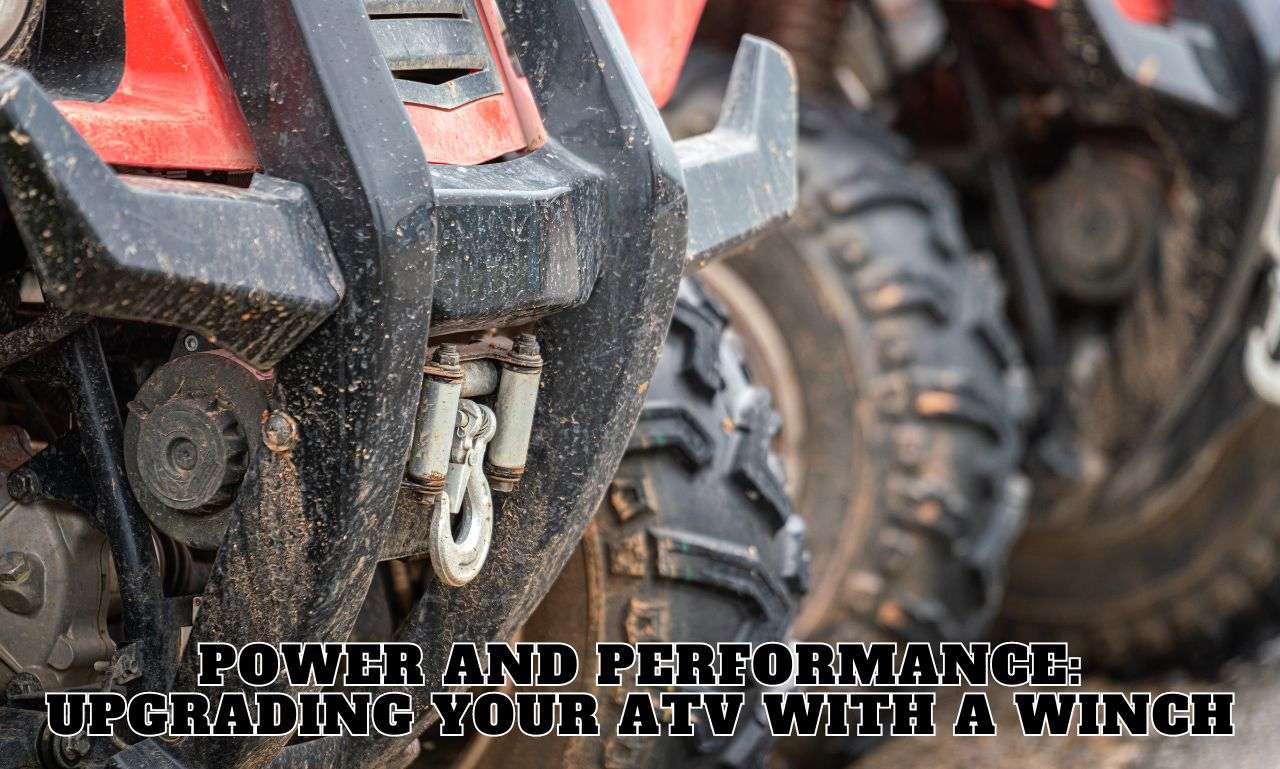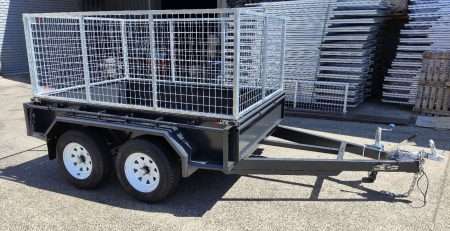
Power and Performance: Upgrading Your ATV with a Winch
Understanding ATV Winches
Before diving into the details of choosing and using an ATV winch, let’s first comprehend what an ATV winch is and how it works.
What an ATV Winch Is
An ATV winch is a versatile tool designed for off-road recovery, towing, and other heavy-duty tasks. Due to their strength and resilience, farmers, and users of off-road vehicles frequently use them. ATV winches can have a pulling capacity ranging from 2,500 lbs to 6,000 lbs, allowing users to choose a winch that matches their specific needs and requirements.
How an ATV winch works
The pulling power of an ATV winch, also called its rated line pull, is the maximum amount of weight the winch can safely pull. An electric motor turns a drum around which the winch’s cable or rope is wound to produce this power. When the motor is activated, the drum rotates, winding the cable in and pulling the attached load towards the winch.
ATV winches can use either steel cables or synthetic rope. Synthetic rope is strong and less dangerous if it breaks, but it can wear down faster and melt if exposed to nearby heat sources. Steel cables, on the other hand, will not melt but they may splinter.
In summary, an ATV winch is a powerful tool that can pull heavy loads, making it an essential accessory for ATV owners who use their vehicles for towing or off-road recovery. Understanding how it works is fundamental to operating it safely and effectively. For other towing needs, consider exploring other products like a trailer brake controller or a hitch receiver.
Key Components of ATV Winches
When it comes to understanding the complex workings of an ATV winch, it’s crucial to familiarise yourself with its key components. Each part plays a significant role in the overall operation and performance of the winch. The three main components you should know about are the electric motor, the cable or rope, and the controls.
The electric motor
The heart of an ATV winch is the electric motor. With the aid of a rope or cable, this crucial component uses the vehicle’s battery’s power to pull an object toward it (RideNow Apache Junction Blog). There are two types of motors available for off-road ATVs: hydraulic and electric. However, electric winches, powered by the vehicle’s battery, are the better choice for ATVs. They can have either a worm gear train or a planetary gear train, with the latter being faster but generating more heat (RideNow Apache Junction Blog).
The cable or rope
An ATV winch uses either a steel cable or synthetic rope to tow or haul. The choice between these two largely depends on the specific requirements of the user. Synthetic cable is both lighter and stronger than steel cable for pulling. It’s also much safer if it snaps. However, it requires more maintenance and can’t take a lot of heat, so it’s a better choice for slower winches (Enthuze). On the other hand, steel cables will not melt, but they may splinter (RideNow Apache Junction Blog).
The Controls
Operating an ATV winch is made possible through the use of controls. These can either be a handheld remote control or a switch on the vehicle’s dashboard. The choice between these control options depends on the user’s preference and the specific situation in which the winch is being used.
By understanding these key components and how they work together, you can make the most of your ATV winch, whether you’re using it for recreational off-roading or for more demanding tasks such as vehicle recovery. Remember, it’s important to choose a winch with enough capacity to handle the weight of the vehicle or object you’ll be pulling.
Choosing the Right ATV Winch
Selecting the right ATV winch involves assessing several factors that will impact your off-roading experience. These considerations include the pulling capacity of the winch, the type of cable used, and the cost of the winch.
Pulling Capacity Considerations
One of the primary considerations when choosing an ATV winch is its pulling capacity. This is typically measured in pounds and denotes the maximum weight that the winch can safely pull. ATV winches come in different capacities, ranging from 2,500 lbs to 6,000 lbs, allowing users to choose a winch that matches their specific needs and requirements.
The rated line pull, or the maximum weight the winch can safely pull, is what determines an ATV winch’s pulling power. Therefore, it’s crucial to select a winch with enough capacity to handle the weight of the vehicle or object you’ll be pulling.
Cable vs. Synthetic Rope
ATV winches can use either steel cables or synthetic rope. Each type of cable has its own advantages and drawbacks.
Steel cables will not melt, but they may splinter, which can pose a safety hazard. On the other hand, synthetic rope is strong and less dangerous if it breaks, but it can wear down faster and melt if exposed to nearby heat sources.
Synthetic cable is both lighter and stronger than steel cable for pulling. It’s also much safer if it snaps. However, it requires more maintenance and can’t take a lot of heat, so it’s a better choice for slower winches.
Cost Factors
The cost of an ATV winch can vary widely depending on its pulling capacity, the type of cable used, the brand, and other features. While higher-end models may offer additional features and greater durability, budget-friendly options can also provide reliable performance for most ATV users.
When considering the cost of an ATV winch, it’s important to consider not only the upfront price but also the potential maintenance costs. For instance, while synthetic rope may initially cost more than a steel cable, it may require more frequent replacement due to wear and tear.
In conclusion, when choosing an ATV winch, it’s important to consider the specific requirements of your ATV and your typical usage scenarios. This will help you select a winch that provides the best balance of performance, safety, and value for your needs. For more information on ATV winches and related accessories, check out our articles on electric winches, trailer winches, and boat trailer winches.
Best Practices for ATV Winch Use
Proper usage and maintenance of your ATV winch can ensure its longevity and optimal performance. This section will guide you through safe usage guidelines and maintenance tips.
Safe Usage Guidelines
When using an ATV winch, safety should always be your top priority. First, make sure you understand how your winch works, and be sure to read and follow the manufacturer’s instructions. Remember that an ATV winch exerts force to pull an object towards it with the help of a rope or cable (RideNow Apache Junction Blog). Therefore, it’s crucial to ensure that the object you’re winching is secure and that the area around it is clear.
The pulling capacity of ATV winches can range from 2,500 lbs to 6,000 lbs, depending on the model. It’s important to choose a winch with enough capacity to handle the weight of the vehicle or object you’ll be pulling. Don’t exceed the weight limit of your winch, as this could lead to equipment failure or injury.
When using the winch, be aware of the power source. Some ATV winches require two batteries to operate. Always check the amp and voltage rating information for your winch to find out if one battery will be sufficient (Offroad-ED.com). Keep an eye on your voltage gauge during winching to ensure your battery will have enough power to start your ATV.
Maintenance Tips
Keeping your ATV winch in good working order involves regular maintenance. Always check the owner’s manual and follow all recommended maintenance procedures to keep your winch operating safely and correctly (Offroad-ed.com).
If your winch is equipped with synthetic rope, keep in mind that it requires more maintenance than steel cables. This is because synthetic ropes can’t take a lot of heat, making them a better choice for slower winches.
Regularly inspect the winch for any signs of damage or wear. This includes checking the cable or rope for frays or kinks and examining the electric motor and controls for any signs of malfunction. If you notice any issues, it’s important to address them immediately to prevent further damage.
Remember, taking good care of your winch ensures it’s ready to help you out of a tough spot when you need it most. Whether you’re using your winch for vehicle recovery, pulling down trees, or other unconventional uses, proper usage and maintenance are key to its performance and longevity.
Popular ATV Winches on the Market
In the world of ATV winches, a few models stand out as top performers. These winches combine power, durability, and reliable operation to provide the best experience for ATV users. Here, we’ll take a look at some of the top-rated and budget-friendly ATV winches that are popular on the market.
Top-rated Winches
- The Warn VRX 35 is a top-rated ATV winch capable of pulling up to 3,500 pounds with a 50-foot wire rope.
- The Smittybilt X2O is a heavy-duty ATV winch that can handle up to 10,000 pounds with its 98.5-foot synthetic rope.
- The Warn 89040 Vantage 4000 ATV Winch is lauded for its reliability, power, and durability. It has a 4000 lb. pulling capacity, a 50-foot synthetic rope, and a reliable motor.
- The Smittybilt 97495 XRC Winch is another top pick with a 9500 lb. pulling capacity, a 94-foot steel cable, and a series-wound motor. It also comes with a wireless remote control (WebbikeWorl).
- The Smittybilt 98510 X2O Waterproof Synthetic Rope Winch is a high-performance option with a 10000 lb. pulling capacity, a 98.5-foot synthetic rope, and a 6.6 horsepower motor. It also features a wireless remote control and a dynamic braking system.
Budget-friendly Winches
- The Champion 3000-lb ATV/UTV Winch is a budget-friendly option with a 3,000-pound capacity and a 46-foot wire rope (Field & Stream).
- The Superwinch 1135230 Terra 35 ATV Winch is a budget-friendly option with a 3500 lb. pulling capacity, a 50-foot synthetic rope, and a sealed permanent magnet motor.
- The Champion Power Equipment 14560 ATV/UTV Winch is a reliable option with a 4500 lb. pulling capacity, a 38-foot galvanised steel cable, and a 1.6 horsepower motor. It also has a free-spooling clutch and a handheld remote control.
By understanding the capabilities and limitations of different winch models, you can make an informed decision about which winch is the best fit for your ATV. Consider your ATV’s weight, your typical usage scenarios, and your budget when choosing an ATV winch. For more information about other towing and hauling gear, check out our articles on hitch receivers, trailer brake controllers, and trailer hitch locks.
Unconventional Uses for ATV Winches
While ATV winches are primarily designed for all-terrain vehicles, their utility extends far beyond the trails. These devices, which exert force to pull an object towards them with the help of a cable or rope, can be put to a number of creative uses. Here, we explore some non-traditional uses of ATV winches.
Vehicle Recovery
One of the most common unconventional uses of an ATV winch is for vehicle recovery. Whether it’s an ATV, truck, or off-road vehicle that’s stuck in mud, snow, or other challenging terrain, an ATV winch can be a lifesaver. By tying the winch cable to a sturdy anchor point and engaging the winch motor, the stranded vehicle can be drawn towards the anchor, effectively liberating it from its predicament.
The pulling power of an ATV winch can range from 2,500 lbs to 6,000 lbs, depending on the model. Therefore, it’s essential to ensure that the winch has enough capacity to handle the weight of the vehicle. For more information on choosing the right winch, refer to our article on electric winches.
Pulling down trees
Another interesting use of an ATV winch is for pulling down trees. If a tree needs to be removed from a particular area, an ATV winch can provide the necessary force to bring it down in a controlled manner. The winch cable or strap is attached to the tree, and tension is applied to safely and gradually fell the tree. This is a task that should be approached with caution and, preferably, undertaken by experienced personnel.
Other Uses
ATV winches can be used to haul objects towards the vehicle, which can be helpful in assisting a friend’s stuck vehicle or moving heavy objects (RideNow Apache Junction Blog). The winch can also be used to pull a boat onto a trailer, making it a useful tool for boating enthusiasts. Check out our article on boat trailer winches for more information.
In conclusion, ATV winches are versatile tools that can be employed in a variety of situations beyond their conventional use. Whether it’s for vehicle recovery, tree removal, or hauling heavy objects, an ATV winch can often provide the muscle needed to get the job done.
Author
I am Rahatul Ashiq Tamal. Another author of Muscle Trailers. Muscle Trailers is a well-known trailer brand in Sydney, Melbourne & Adelaide

How to Mount a Spare Tire on Your Trailer: A Simple Step-by-Step Guide
Trailer service centers receive over 1 million phone calls and 1.3 million emails each year about trailer maintenance problems....

How to Fix RV Roof Leaks: Simple Roof Leak Detection Guide for Beginners
Did you know DIY RV roof repairs can cost under $50? But undetected leaks could lead to substantially higher repair...

Starting a Food Truck Business in Australia: From Trailer Selection to Launch
The Australian mobile food market has evolved into a billion-dollar industry. This makes a food truck...
